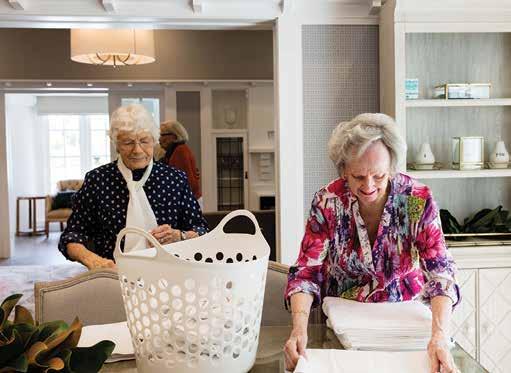
5 minute read
EDGECLIFF
Group Homes Australia is an table, family photo albums, a resident’s Living life with dignity and purpose innovative and world-leading model knitted blanket that they brought from home, offering dementia care, high care, and maybe even a pet, or a basket of laundry respite and palliative care in a welcoming environment that values independence and resident involvement in the daily activities waiting to be folded, and a fireplace, creating a warm, cosy environment. The kitchen looks and smells like a kitchen where there are freshly baked muffins, the kettle ready to be boiled and a soup simmering of the home. Residents live with on the stove. Before a meal, residents will be dignity and a sense of purpose in a encouraged to participate in chopping and small scale environment. peeling vegetables and setting of the table. The Group Homes model is the first of its kind in Australia and focuses on creating a home, instead of an institution, that emphasises the resident’s abilities rather than their disabilities. Each home has trained staff on site 24/7, The garden is open and inviting. A resident will walk into the garden and find a vege patch that needs to be watered, leaves that need raking and a space that is tranquil and inviting. called Homemakers, a high ratio of carers to Group Homes Australia has homes in Sydney’s residents – and is the very opposite of the North Shore (St Ives and Turramurra), Northern institutionalised care model. Beaches (Warriewood) and Eastern Suburbs The Homemakers work alongside residents to get them involved in all sorts of day-to-day activities of living. This could be cooking, (Vaucluse, Rose Bay and Queens Park) and Inner West (Hunters Hill) and Sutherland Shire (Caringbah). gardening, or shopping: anything that is This innovative model of care is an alternative purposeful and meaningful for that person. to traditional aged care facilities. Smaller care They work hard to support people with environments have been proven to increase dementia to stay active in their local quality of life, reduce rates of depression and communities – whether that’s by teaching the reduce hospitalisation for people living local café staff a few things about dementia, with dementia. or by supporting a resident to keep up with walks around their neighbourhood. At Group Homes Australia, there is a focus on the needs and wants of each individual At Group Homes Australia, the design and resident, no matter their care level. It allows environment are part of the therapy. No residents to receive the care and support that matter where a resident goes in the home, the they need, while still living with dignity environment is friendly and functional. It looks and purpose. and feels like an ordinary home. GROUP HOMES Residents know that a living room is a living room because there is a lounge, a coffee
1300 920 894 www.grouphomes.com.au
Advertisement

THE BUILDERS OF MODERN AUSTRALIA
We continue to explore the important contributions of past parishioners of St Mark’s Anglican Church, Darling Point. THOMAS SUTCLIFFE MORT -
Part One
TS Mort is one of the greatest Australians. He strode like a colossus across early Sydney and his influence was immense. He was a man of great vision and profound humanity and was a great inspiration to others. His commitment to the development of a fair and prosperous Australian society is his greatest legacy.
As a result of reduced family circumstances and prospects in his native Lancashire, Thomas Mort arrived in Sydney in 1838 at the age of 21 with little capital. He rapidly rose to prominence in the colony through hard work and drive. In the words of contemporary biographer JH Heaton, “Mr Mort was more or less identified with nearly every movement for the advancement of New South Wales, and by his business talents, indomitable enterprise, public spirit, and high character exercised a great power for the general good”. When he died in 1878, his reputation was such that, in a rare act, the public subscribed funds to raise a statue to his honour in Macquarie Place.
Mort’s family motto was “Persevere to Succeed”. To this he added a towering intellect and outstanding business acumen.
He personally started many commercial ventures and pastoral enterprises, including pioneering the auctioneering of wool (today’s Elders). He was a Founder of the AMP Society, sugar growing in Moreton Bay district, the Sydney Railway Company, Mort’s Docks at Balmain (the first dry dock in Australia), land sub-division at what is now the suburb of Mortdale, the establishment of a unique dairy industry at Bodalla, various mining enterprises and he established the first freezing works in the world. While many of his deeds were ground-breaking, perhaps his greatest achievement was pioneering the refrigeration industry, particularly in regards to transportation over long distances which facilitated the supply of Australian meat and dairy products to the rest of the world.

Most ordinary men would be lauded for their singular effort in any one of these endeavours and yet Mort was promoter, financier and passionate instigator of so many of the worthwhile economic and social movements of early Australia. According to Prof Barnard in Visions and Profits, while eschewing public life, he maintained two underlying beliefs; “that the material welfare of the community did depend on the successful cooperation of capital and labour; and that a prosperous community could rid itself of social ills”.
St Mark’s itself is on land provided by TS Mort as part of his Greenoaks estate which partially exists today as ‘Bishopscourt’.
At a time when it took four months for news to arrive from the old country, churches were places where men of influence gathered not only to express their faith but to exchange ideas for the new society. Many of Sydney’s new enterprises and lasting benevolent activities were initiated from such conversations led by TS Mort. Next month in Part Two of his story we will further discuss some of his legacy that shaped our emerging nation.
For more information please contact history@stmarksdp.org or visit
https://stmarksdp.org/history/
Ian Tresise St Mark's Historical Society


